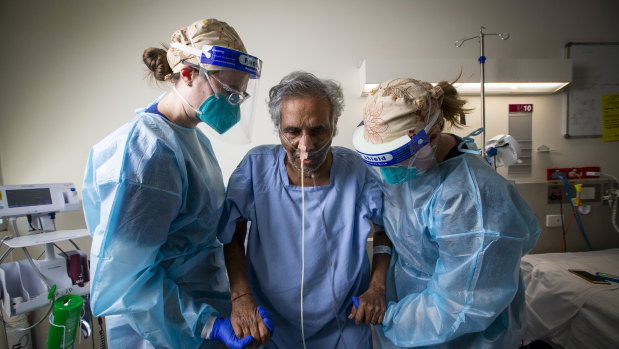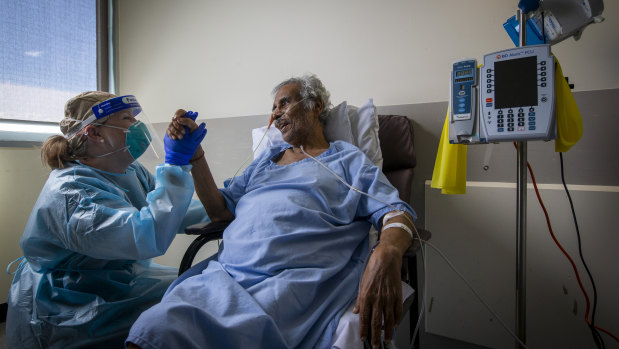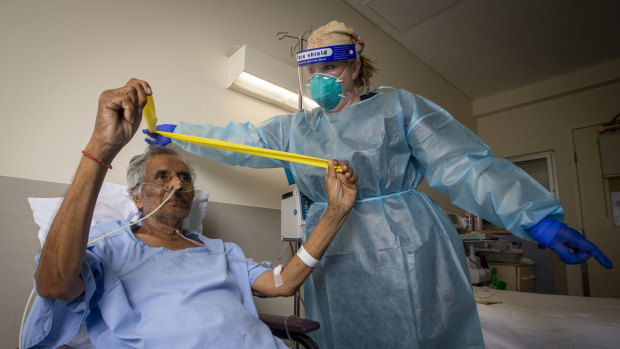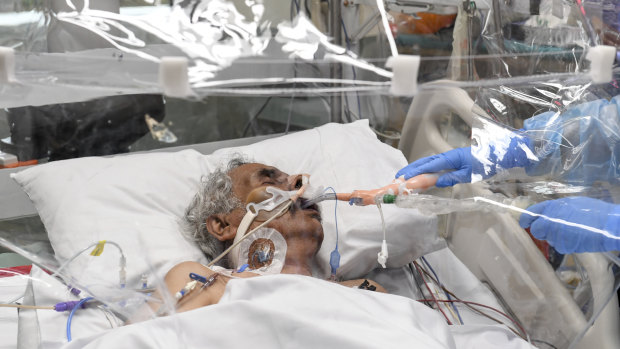This was published 3 years ago
'Am I going to survive?' The lingering effects of coronavirus and the long, hard road to recovery
"Am I going to survive?"
They were the first words Viswanathan Nair had spoken in weeks. His voice was hoarse and he was gasping for air as a nurse checked his vitals at Footscray Hospital’s intensive care unit.
Mr Nair had been intubated and hooked up to a ventilator for almost a month after being hospitalised with coronavirus in July. As he lay under a ventilation hood made of thick transparent plastic, his body withered away.

COVID 19 survivor Viswanathan Nair and ICU physiotherapists Kimberley Haines (right) and Nina Leggett at Footscray Hospital.Credit: Wayne Taylor
He had dreams he was a boy again, running in the searing heat along the streets of South India, and had vivid visions of loved ones who had died before him.
Doctors were uncertain he would survive. But almost six weeks in, something extraordinary happened. Mr Nair had beaten the mysterious virus that had ravaged his body.
He faced a new and difficult challenge: the long road to recovery. Shortness of breath, fluid on the lungs, whittled away muscles. Flashbacks, confusion and scarring or inflammation of the lungs, heart, kidneys and liver. These are just some of the lingering effects of those who become seriously ill with coronavirus.

COVID 19 survivor Viswanathan Nair and ICU physiotherapist Kimberley Haines at Footscray Hospital. He faces an uphill battle as he learns to walk on his own again.Credit: Wayne Taylor
Western Health senior ICU physiotherapist Kimberley Haines is leading a team of about 40 highly-trained physiotherapists who are helping save the lives of coronavirus patients. They are also teaching people like Mr Nair how to walk again.
While Dr Haines is experienced in the rehabilitation of critically ill patients suffering intensive care-acquired weakness, there are striking differences with coronavirus.
“With Mr Nair, it was really marked to me just how brittle his lung function was,” Dr Haines said.
“We stood him up next to his bed and we got him to slowly march on the spot. His breathing just skyrocketed, equivalent to you or I climbing a set of stairs. What this virus does is it devastates the lungs so it’s going to be really interesting to see how long it takes for these patients to recover because their breathlessness often hinders the amount of physical movement they can do.”

Viswanathan Nair does exercises to clear the fluid from his lungs with ICU physiotherapist Kimberley Haines.Credit: Wayne Taylor
Mr Nair may not have been aware of it at the time, but the same physiotherapists helping him were rolling him onto his stomach when he was struggling to breathe.
Known as proning, the technique can help those in severe respiratory distress by relieving the effects of gravity and opening up new regions of lung tissue for air. It can be the difference between life and death.
Western Health now has the highest number of critically ill and recovering coronavirus patients in Australia.
While the vast majority of those struck down with the virus will make a full recovery, a smaller, more complex cohort must undergo intense physical therapy and personalised treatments.
About 14 percent have a severe infection, and a further six percent, such as Mr Nair, will become critically ill. Dr Haines has seen young patients bounce back in weeks, but for older patients and those with underlying illness full recovery often takes several months.

Viswanathan Nair in intensive care.Credit: Penny Stephens
Mr Nair, who lives with his wife, son, daughter-in-law and nine-year-old granddaughter Aashi, does not know how his family were exposed to the virus. All were infected except Aashi.
His son, Abhi, suspects he may have caught the virus at the supermarket.
"It has changed my perspective completely on this virus," his son Abhi said. "It was really distressing seeing dad, struggling to breathe ... having to call an ambulance then not being able to be with him for weeks when he was so close to death."
For those with severe infections, even the smallest movements can be exhausting and trigger rapid drops in oxygen levels.
Mr Nair's vital organs are functioning well, but his lungs still feel like they are being crushed by slabs of concrete.
Each week, he is reaching small milestones. He is slowing learning to walk again. Before coronavirus, he spent hours walking each morning and loved tending to the garden and pruning his son's roses.
He has learned to sit on the edge of his bed, to stand up on his own, march on spot and has finally taken his first steps.
Breathing techniques are used daily to promote coughing to help clear the fluid on his lungs as physiotherapists guide him from behind pale blue isolation gowns, masks and face shields.
Pedalling helps those recovering from the virus improve cardiovascular health and weights are used to build up lost muscle strength.
Being in an intensive care unit can be an isolating, terrifying and dehumanising experience, Dr Haines said.
"Our job is to restore a person's humanity and function," she said.
“It’s really powerful when you see intensive care survivors in the same room. It’s very emotional because they’ve gone through this really hard time and then they see somebody else who has experienced what they have and they realise they are not alone."
For now, Mr Nair's goal is to walk again on his own. Soon, he hopes to go home and hug his granddaughter and have fish and chips for dinner with his family.
"I know I'm very lucky to be here," Mr Nair said. "But I owe my life to the excellent people at Footscray Hospital who have cared for me. They are some of the best people."